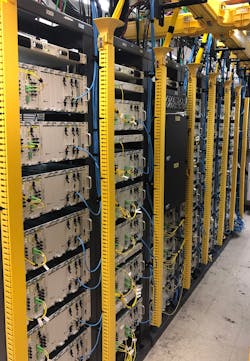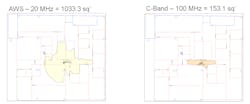Latest from 5G/6G & Fixed Wireless Access/Mobile Evolution
Because 5G Mid-Band Experience Needs to be Juuuust Right
5G Americas updated their forecast on April 4, 2023. Global 5G connections are expected to continue their acceleration in 2023, approaching 2 billion and reaching 5.9 billion by the end of 2027.
Worldwide adoption of 5G is accelerating at a lightning-fast pace, with the number of 5G connections expected to reach 2 billion by 2025.1 As demand grows, mobile network operators (MNOs) in the US are taking advantage of recently available mid-band frequencies to build-out their networks and enhance wide-area 5G capacity and speed for a better user experience.
Nonetheless, most subscribers are not experiencing true 5G service. That's partly because about 80%2 of all mobile voice and data traffic occurs indoors, where wide-area network signals tend to be blocked or diminished. And unfortunately, most legacy distributed antenna systems (DAS) that provide in-building connectivity for mobile voice and data devices cannot support the new mid-band frequencies, including the C-Band spectrum (3.7-3.98 GHz) and Auction 110 bands (3.45-3.55 GHz).
To ensure 5G quality of experience (QoE) throughout commercial buildings, offices, multi-dwelling units (MDUs), and event venues, today's installed base of DAS equipment needs to be updated, replaced, or overlaid with new infrastructure.
What’s With the Goldilocks Reference?
Mid-band frequencies provide an ideal mix of the speed of high spectrum bands and the coverage of low bands. This combination, often referred to as the "Goldilocks" spectrum, provides MNOs with a "just right" blend of frequency characteristics to enhance coverage, capacity, and speed for a better user experience.
Since the 1970s, the Federal Communications Commission (FCC) has reserved the C-Band for satellite TV transmissions. But with the advent of advanced digital encoding methods, satellite companies could "repack" their broadcasts into the upper portion of the band, thereby freeing up the lower portion for 5G. However, the full C-Band allocation is being made available in two phases through 2023 as the FCC clears the spectrum.
Although Tier 1 service providers have already begun activating C-Band 5G networks, each operator's timeframe for C-Band availability depends on their specific license. That means that initial 5G deployments in C-Band will extend through the end of next year, with different portions of the band used by the MNOs in various major markets.
As a result of the two-phase release schedule, network planning for mid-band 5G can be rather complex. This situation is further complicated because the initial spectrum allocated to one major MNO will shift, on average, 80 MHz higher within the band in 2023.
"…after updating legacy DAS infrastructure to support the mid-band frequencies, in-building coverage configurations may require changes, such as increasing up to 10x higher signal levels for mid-bands due to the signal propagation characteristics of the new 5G frequencies. Otherwise, the in-building 5G service will not deliver the desired QoE."
Plan for Growth
Legacy DAS installations require upgrades, such as replacing passive splitters and antennas, to support the new mid-band frequencies. After these upgrades, mid-band 5G radios may connect to these systems depending on the power level of the legacy 4G radios. In some buildings, it is not practical to make these upgrades, which could lead to an entire replacement of the DAS—a costly undertaking for building owners and third-party operators. In these circumstances, an overlay system engineered for the mid-band may be more cost-effective.
In both scenarios, it's best to plan to support the fully occupied C-Band spectrum from day one to prepare for frequency band changes in the near future and keep up with rising 5G capacity demand. In addition, it also would be prudent to include Auction 110 spectrum in your planning to provide space for its amplifiers as well.
Additionally, another future-ready consideration when choosing DAS infrastructure is the type of technology used. As convergence in communications technologies drives more and more fiber throughout the entire communications network, a common fiber infrastructure from end-to-end offers an opportunity for improved speed and capacity, as well as increased security.
Fiber-to-the-edge technology carries voice and data all the way to the edge of the DAS network, enabling faster speeds, higher bandwidth, and lower latency at each access endpoint throughout a building or campus. Plus, fiber-to-the-edge technology provides a scalable evolution path to support technology upgrades. These upgrades may include future DAS capacity expansion, such as a mid-band overlay, and future frequency bands as the FCC releases additional spectrum and MNOs begin to turn off previous mobile generations. Fiber installed end-to-end also allows a building or venue owner to install additional equipment they may need outside of DAS.
Overcome Obstacles
Yet, even after updating legacy DAS infrastructure to support the mid-band frequencies, in-building coverage configurations may require changes, such as increasing up to 10x higher signal levels for mid-bands due to the signal propagation characteristics of the new 5G frequencies. Otherwise, the in-building 5G service will not deliver the desired QoE.
For example, because the C-Band spectrum spans higher frequencies, it offers just one-fourth of the signal propagation characteristics of legacy Advanced Wireless Service (AWS) mobile communications bands. Plus, the increased channel size of the C-Band also means that it delivers coverage over a smaller area. As a result, matching the coverage footprint of legacy DAS deployments with C-Band will require a higher effective output power from the antenna to compensate for excessive signal loss and reduced coverage.
Furthermore, the higher frequencies of the mid-band spectrum do not penetrate building materials as well as lower frequencies. Because signals tend to bounce off or get attenuated by metal, concrete, and Low-E glass, coverage from outdoor networks is less likely to provide service inside buildings.
Interior walls, furniture, and other building materials also can impede mid-band frequencies. Compared to legacy AWS frequencies at the same power level, indoor C-Band coverage is roughly 15% per antenna. In fact, in an office environment with sheetrock walls, an antenna providing a little more than 1,000 square feet of coverage with a 4G 20 MHz channel in the legacy band would only cover a little more than 150 square feet with a 5G 100 MHz channel in the C-Band.
Most existing 4G systems will require amplifiers that provide 4 to 10 times more output power for mid-band 5G to match the existing footprint. However, increasing power may not be feasible if the existing system already uses high-output power amplifiers. In those cases, the best solution may be to use an overlay system engineered specifically for the coverage requirements at the higher frequencies.
Sophisticated link budget analysis tools can facilitate the analysis of factors unique to each in-building deployment to optimize capacity and coverage for the 5G mid-band. Similarly, a rough order magnitude (ROM) pricing tool comes in handy to begin the budgeting process early, given all the technical complexities and often unforeseen results of the engineering design process.
“…most subscribers are not experiencing true 5G service. That's partly because about 80% of all mobile voice and data traffic occurs indoors, where wide-area network signals tend to be blocked or diminished.”
Fulfill the 5G Promise
The valuable new mid-band spectrum presents an ideal blend of characteristics for 5G networks. As 5G demand continues to skyrocket, however, expectations for high-quality voice and data services are also rising, including throughout commercial buildings, offices, event venues, and other MDU structures.
To ensure seamless indoor 5G connectivity, building owners, third-party operators, and MNOs need to update legacy DAS systems to remain competitive. With next-generation DAS equipment that supports the entire C-Band and Auction 110 spectrum, such as SOLiD ALLIANCE 5G3 DAS remote models, network managers can keep pace with future demand while avoiding an expensive "rip and replace" scenario. In this way, operators can fully leverage the new mid-band spectrum to deliver a true 5G experience that is "just right" for subscribers wherever they find themselves.
REFERENCES AND NOTES
1. https://www.gsma.com/mobileeconomy/#trends
2. https://www.eetimes.com/with-5g-indoor-coverage-is-a-challenge/
3. https://solid.com/us/resources/
ABOUT THE AUTHOR
Slavko Djukic is Vice President, Product Line Management and Technology, of SOLiD Americas. He has more than 20 years of experience in telecommunications products and services. For more information, email [email protected] or visit www.solid.com/us/. Follow Slavko on LinkedIn: https://www.linkedin.com/in/slavko-djukic-3b19016/. Follow SOLiD on LinkedIn: https://www.linkedin.com/company/solid-technologies/ and YouTube: https://www.youtube.com/channel/UCAGgwjhqh-4xUVigSeb4d3w.

Slavko Djukic | Vice President, Product Line Management and Technology, SOLiD Americas
Slavko Djukic is Vice President, Product Line Management and Technology, of SOLiD Americas. He has more than 20 years of experience in telecommunications products and services. For more information, email [email protected] or visit www.solid.com/us/.
Follow Slavko on LinkedIn: https://www.linkedin.com/in/slavko-djukic-3b19016/.
Follow SOLiD on LinkedIn: https://www.linkedin.com/company/solid-technologies/ and YouTube: https://www.youtube.com/channel/UCAGgwjhqh-4xUVigSeb4d3w.
Prior to joining SOLiD, Slavko served as Zinwave's Chief Technology Officer, responsible for the company's wireless technology roadmap. He has also held leadership positions at Ericsson, Corning, and Powerwave. He holds a B.S. in Electrical Engineering from the University of Alabama and a Master of Science in Electrical Engineering from the University of Colorado.






